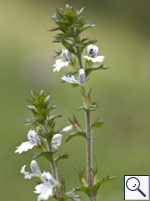|
||||||
|
EUPHRASIA. Eyebrights. [Scrophulariaceae] |
|
|
Twenty-one species of Euphrasia are recorded in Britain. All except one are native. The BSBI provide a downloadable plant crib for Euphrasia. Only one British miner is recorded on Euphrasia. The agromyzid Phytomyza affinis is recorded in Co. Clare and elsewhere feeding in the seeds of Euphrasia. A key to the European miners recorded on Euphrasia is provided in Bladmineerders van Europa. |
 Common Eybright Euphrasia nemorosa |
Key for the identification of the known mines of British |
1 > Leaf-miner: Oviposition takes place in an upper leaf and a short mine is formed either in the leaf or stem, but the larva feeds primarily in the stem. Pupating in the stem (Spencer, 1976: 487 (fig. 857), 488). Short and narrow corridor in the leaves, bracts or even calyx, ending in a thick vein. From there the larva descends as a borer. Infested plants largely die off. Pupation and hibernation within the mine. |
|
Phytomyza rostrata Hering, 1934 [Diptera: Agromyzidae]. |
| Last updated 04-Jul-2019 Brian Pitkin | ||
